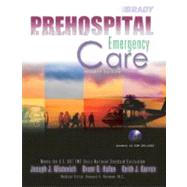
| Detailed Contents | p. vi |
| Assessment Summaries/Emergency Care Protocols/Algorithms/Drug Profiles | p. xiv |
| Photo Scans | p. xv |
| Acknowledgments | p. xvii |
| Author's Letter to Students | p. xix |
| About the Authors | p. xxi |
| Guide to Key Features | p. xxiii |
| Preparatory | |
| Introduction to Emergency Medical Care | p. 1 |
| The Well-Being of the EMT-Basic | p. 12 |
| Medical, Legal, and Ethical Issues | p. 29 |
| The Human Body | p. 40 |
| Baseline Vital Signs and History Taking | p. 72 |
| Preparing to Lift and Move Patients | p. 86 |
| Airway | |
| Airway Management, Ventilation, and Oxygen Therapy | p. 95 |
| Patient Assessment | |
| Scene Size-Up | p. 142 |
| Patient Assessment | p. 160 |
| Assessment of Geriatric Patients | p. 238 |
| Communication | p. 258 |
| Documentation | p. 270 |
| Medical, Behavioral, and Obstetrics/Gynecology | |
| General Pharmacology | p. 283 |
| Respiratory Emergencies | p. 294 |
| Cardiac Emergencies | p. 323 |
| Automated External Defibrillation | p. 348 |
| Altered Mental Status and Diabetic Emergencies | p. 369 |
| Acute Stroke: Altered Speech, Sensory Function, Motor Function, or Mental Status | p. 393 |
| Seizures and Syncope | p. 409 |
| Allergic Reaction | p. 422 |
| Poisoning Emergencies | p. 438 |
| Drug and Alcohol Emergencies | p. 462 |
| Acute Abdominal Pain | p. 478 |
| Environmental Emergencies | p. 493 |
| Drowning, Submersion, and Diving Emergencies | p. 525 |
| Behavioral Emergencies | p. 543 |
| Obstetric and Gynecological Emergencies | p. 559 |
| Trauma | |
| Mechanisms of Injury: Kinetics of Trauma | p. 590 |
| Bleeding and Shock | p. 608 |
| Soft Tissue Injuries | p. 632 |
| Burn Emergencies | p. 655 |
| Musculoskeletal Injuries | p. 675 |
| Injuries to the Head | p. 700 |
| Injuries to the Spine | p. 717 |
| Eye, Face, and Neck Injuries | p. 756 |
| Chest, Abdomen, and Genitalia Injuries | p. 777 |
| Agricultural and Industrial Emergencies | p. 805 |
| Infants and Children | |
| Infants and Children | p. 816 |
| Operations | |
| Moving Patients | p. 863 |
| Ambulance Operations | p. 881 |
| Gaining Access and Extrication | p. 903 |
| Hazardous Materials Emergencies | p. 917 |
| Multiple-Casualty Incidents | p. 936 |
| EMS Response to Weapons of Mass Destruction | p. 952 |
| Advanced Airway Elective | |
| Advanced Airway Management | p. 969 |
| Basic Life Support | p. 1 |
| National Registry Skill Sheets | p. 1 |
| Glossary | p. 1 |
| Index | p. 1 |
| Table of Contents provided by Rittenhouse. All Rights Reserved. |
The New copy of this book will include any supplemental materials advertised. Please check the title of the book to determine if it should include any access cards, study guides, lab manuals, CDs, etc.
The Used, Rental and eBook copies of this book are not guaranteed to include any supplemental materials. Typically, only the book itself is included. This is true even if the title states it includes any access cards, study guides, lab manuals, CDs, etc.